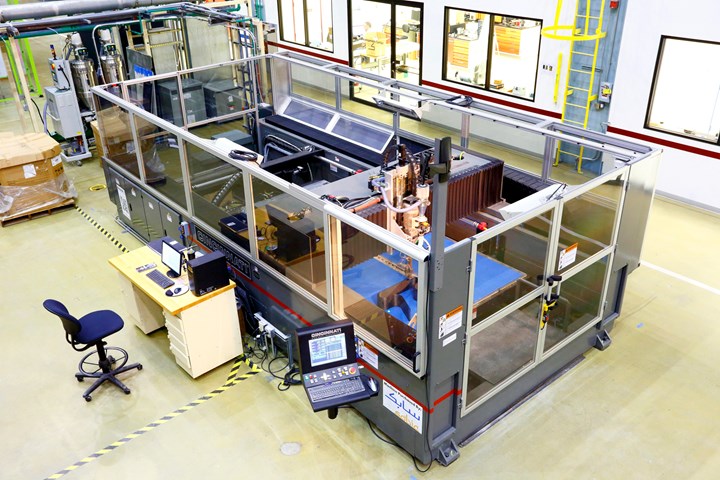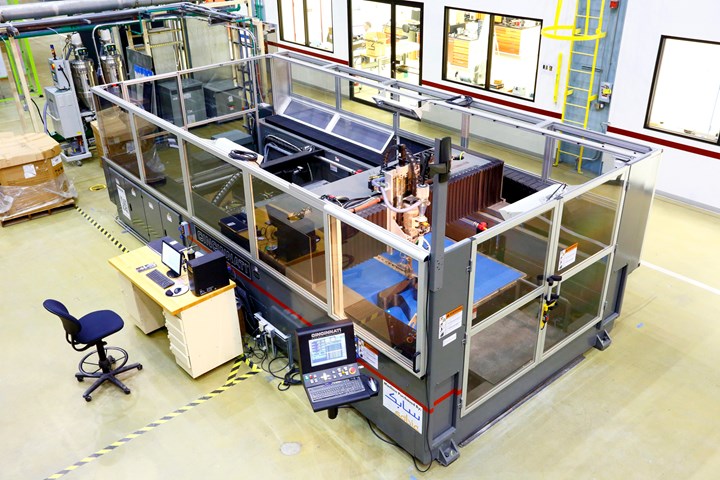
SABIC and Local Motors Study Demonstrates Recyclability of 3D-Printed Parts
Large format additive manufacturing (LFAM) is an exciting technology but there is plenty of room to grow when it comes to incorporating sustainability. Recently, SABIC and Local Motors completed a joint study on the feasibility of recycling scrap thermoplastic parts and shavings from the 3D printing process.
Currently, no established value chain exists for reclaiming post-production LFAM parts and scrap. According to the companies, the complex sequence of steps includes managing the logistics of locating, collecting and transporting large parts to a facility capable of cleaning, cutting, regrinding and repurposing the material.
Another challenge of reusing LFAM materials is potential degradation from multiple heat cycles (grinding, re-pelletizing, re-compounding, etc.). Each step adds to the cumulative heat history, which tends to break down the polymer chains and reduce fiber length and can affect performance. These factors should be considered when identifying opportunities for material reuse.
The study explored more sustainable alternatives to landfilling large, printed parts in anticipation of wider adoption of LFAM. It included analyzing the printability and mechanical properties of SABIC’s LNP THERMOCOMP AM reinforced compound, used by Local Motors, after being printed, reclaimed, ground and reprocessed into pellet form. The study determined that material from post-production parts and scrap can potentially be reused in LFAM or other processes, such as injection molding or extrusion, at amounts up to 100%.
Study Method and Results
The SABIC-Local Motors study included evaluations for printability, throughput and mechanical properties. In order to assess printability, six material samples of LNP THERMOCOMP AM compound were prepared, containing 0, 15, 25, 50, 75 and 100% reprocessed content, respectively. These samples were monitored for changes in throughput and melt flow rate on SABIC’s Big Area Additive Manufacturing (BAAM) machine from Cincinnati Inc., located in the company’s Polymer Processing Development Center in Pittsfield, Mass. Each sample was used to print a single-wall hexagon, which is SABIC’s typical test part geometry for processing and material characterization. All the samples printed well, with a smooth, shiny surface and straight, even layers that demonstrated no issues with material flow.
For the mechanical properties evaluation, specimens were cut from each hexagonal printed part. These were tested for tensile properties using Test Method D638 as a guideline, and for flexural modulus using a three-point bend test following a modified ASTM D-790 test method. Results showed excellent tensile properties in the part samples containing smaller percentages of regrind and only incremental declines in the samples that included larger percentages of regrind. The 100% regrind sample experienced just a 20% reduction in tensile properties in the X direction and a 15% reduction in the Z direction. For flexural properties, the same gradual trend occurred, with flexural modulus declining by just 14% in the X direction and 12% in the Z direction for the sample containing 100% regrind.
As expected, tensile and flexural testing showed decreasing mechanical strength as the percentage of regrind increased. This finding is typical of regrind used in other processes such as injection molding and extrusion.
This study highlights the reusability of post-industrial LFAM shavings and parts. Both post-industrial and post-consumer scrap materials offer potential for reuse; however, existing gaps in the recycling value chain need to be filled before this process can be viable. The companies state that a large collective effort by the LFAM community, including resin manufacturers, converters, 3D printers and recyclers, is needed to devise an economical method of collecting scrap and converting it to a reusable form.
“As adoption of large format additive manufacturing accelerates, it is essential to find sustainable alternatives to landfilling large, printed parts,” said Walter Thompson, senior applications development engineer at SABIC. “SABIC and Local Motors have investigated the practicality of using mechanically ground scrap material and end-of-life parts generated from LFAM. Our study showed great potential for reusing these materials and marks a first step in supporting reuse within the value chain.”
“Building next-generation vehicles means embracing next-generation manufacturing processes,” said Johnny Scotello, director of technical product at Local Motors. “We’re proud to work with SABIC in making large format additive manufacturing more sustainable. Bringing value to scrap or end-of-life parts is a difficult challenge, but the results of this study point to a bright future for sustainable, circular products.”

SABIC and Local Motors completed a joint study on the feasibility of recycling scrap thermoplastic parts and shavings from the 3D printing process.

Leave a Reply